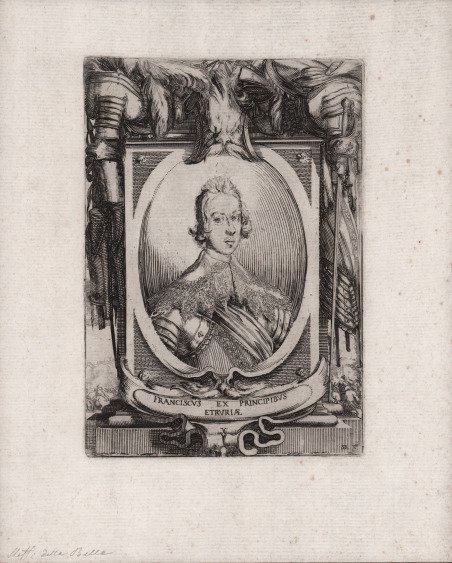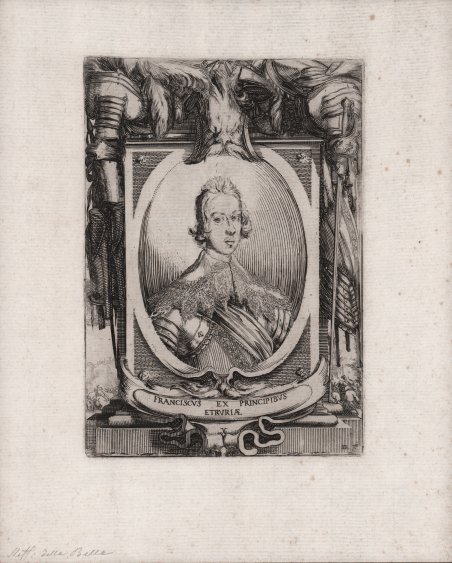Acquaforte, 1634 circa, firmata in basso a destra con il monogramma SDB; iscrizione latina nel cartiglio sotto il ritratto: FRANCISCUS EX PRINCIPIBUS / ETRURIAE. Magnifico esemplare, stampato su carta vergata coeva, ampi margini, in ottime condizioni. Ritratto in ovale di Francesco de' Medici (16 ottobre 1614 - 25 luglio 1634), figlio di Cosimo II, all'età di 19 anni, busto a ¾, rivolto a destra, cornice decorata con armi. Francesco era il quarto figlio del Granduca Cosimo II di Toscana e di sua moglie, Maria Maddalena d'Austria. Celibe, morì di peste durante l'assedio di Ratisbona, 1634. Il ritratto di Della Bella deve essere stato ' realizzato postumo per il libro funebre Esequie del Serenissimo Principe Francesco celebrate in Fiorenza.il dì 30 d'agosto 1634, descritte da Andrea Cavalcanti edito da Landini a Firenze nel 1634 . La sua probabile fonte è il ritratto di Francesco di Justus Susterman negli Appartamenti Reali di Palazzo Pitti. La testa e i lineamenti sembrano essere gli stessi, anche se invertiti nell'incisione. L'armatura, il colletto di pizzo sono simili. Della Bella mostra Francesco senza cappello, e presumibilmente con i propri capelli, piuttosto che con la parrucca del ritratto dipinto. Stefano della Bella fu uno degli incisori più interessanti e originali nella Firenze del XVII secolo e può considerarsi l’unico geniale continuatore dell’opera di Jacques Callot. La sua educazione artistica ebbe inizio a Firenze nella bottega degli orafi Gasparo Mola e Orazio Vanni, e la precisione del segno, tipica dell’arte orafa resterà caratteristica del suo stile. Studiò poi presso Giovanni Battista Vanni e forse anche presso il Cantagallina e Cesare Dandini, ma ben presto si dedicò all'incisione. Il suo vero maestro può considerarsi Jacques Callot, l’incisore francese che soggiornò a lungo a Firenze lasciando una forte impronta nel panorama artistico della città. Gli anni più importanti della sua carriera sono quelli che trascorre a Parigi, dal 1639 al 1650, stipendiato da Lorenzo de' Medici: lavorò insieme ad Israel Silvestre, con gli editori Langlois, Ciartres e Pierre Mariette, per stampatori francesi e per commissioni di gran prestigio, come quelle del 1641 per il cardinale Richelieu che gli affidò le illustrazioni delle sue imprese guerresche. Intorno al 1647, durante un viaggio in Olanda, dove eseguì le acqueforti con le vedute del porto di Amsterdam, incontrò Rembrandt e da quella data notiamo una eco profonda dell’arte dell’olandese nella grafica del Della Bella. Bibliografia De Vesme – Massar, n. 36, p. 54; J. Talbierska, Stefano della Bella: Etchings from the Collection of the Print Room of the Warsaw University Library. Warsaw, 2001, cat. n. 10, p. 43. Etching, 1634 circa, signed at the bottom on the right with bound monogram SDB; latin inscription in ' the cartouche FRANCISCUS EX PRINCIPIBUS / ETRURIAE. Magnificent example, printed on contemporary laid paper, wide margins, in excellent condition. ' Portrait in oval of Francesco de’ Medici (16 October 1614 – 25 July 1634), son of Cosimo II, at his age of 19, bust ¾ to the right, flanked by arms. He was the fourth son of Grand Duke Cosimo II of Tuscany and his wife, Maria Maddalena of Austria. He died, unmarried, from plague during the Siege of Ratisbon, 1634. The portrait by Della Bella must have been made posthumously for Francesco's funeral book, published in 1634 Esequie del Serenissimo Principe Francesco celebrate in Fiorenza…il dì 30 d’agosto 1634, descritte da Andrea Cavalcanti (Landini, 1634) . Its probable source is the portrait of Francesco by Justus Susterman in the Royal Apartments at the Pitti Palace. The head and features appear to be the same, though reversed in the etching. The armor, lace collar, and scarf are similar. Della Bella shows Francesco hatless, and presumably with his own hair, rather than in the wig of the painted portrait. ' Stefano della Bella was one of the most interesting and original engravers in 17th-century Florence and can be considered the only brilliant continuator of Jacques Callot's work. His artistic education began in Florence in the workshop of the goldsmiths Gasparo Mola and Orazio Vanni, and the precision of sign, typical of the goldsmith's art, will remain characteristic of his style. He then studied under Giovanni Battista Vanni and perhaps also under Cantagallina and Cesare Dandini, but soon turned to engraving. His real master can be considered Jacques Callot, the French engraver who stayed in Florence for a long time and left a strong imprint on the city's artistic scene. The most important years of his career were the ones he spent in Paris, from 1639 to 1650, salaried by Lorenzo de' Medici: he worked together with Israel Silvestre, with the publishers Langlois, Ciartres and Pierre Mariette, for French printers and for commissions of great prestige, such as those of 1641 for Cardinal Richelieu, who entrusted him with illustrations of his warlike exploits. Around 1647, during a trip to Holland, where he executed etchings with views of the port of Amsterdam, he met Rembrandt, and from that date we note a profound echo of the Dutchman's art in Della Bella's graphic work. ' Bibliografia De Vesme – Massar, n. 36, p. 54; J. Talbierska, Stefano della Bella: Etchings from the Collection of the Print Room of the Warsaw University Library. Warsaw, 2001, cat. n. 10, p. 43. Cfr.


Découvrez comment utiliser
Découvrez comment utiliser

